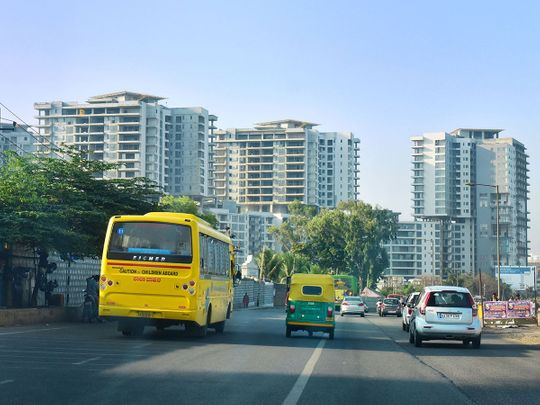
India’s luxury property market may not have been very attractive to resident Indians in the recent past — but it scores high with the NRIs due to their greater buying power. Multiple factors draw their attention.
For one, it promises a high standard of living to them if they chose to return to their country of origin. And second, the rentals can be decent if the property is located in a prominent employment hub. This segment has also not seen the kind of huge unsold inventory witnessed in mid-income housing, largely because builders consciously restricted new supply over the last couple of years.
As per recent research, the overall unsold inventory of luxury homes — priced between Rs15 million (Dh804,800) to Rs25 million — declined to 42,650 units in the first quarter from 48,300 units in 2018. Bengaluru led from the front, recording a significant 49 per cent reduction in unsold luxury stock within a year. It was followed by Kolkata with a 37 per cent decline.
Concurrently, unsold stock in the affordable segment saw an increase of nearly 3 per cent as maximum new launches catered to this segment during the period.
One major feature distinguishing luxury and ultra-luxury properties between various cities is its price range. For instance, properties priced greater than Rs15 million are considered ultra-luxury in Bengaluru while in Mumbai properties priced above Rs40 million fall into this category.
With the resurgence of the Indian economy and the ongoing construction activity in this segment, there has been a concurrent rise in both end-user and investor demand for luxury real estate. Anarock Research states that the returns on investment for luxury and ultra-luxury homes is around 3-5 per cent and 2-3 per cent, respectively.
This may not look handsome at the moment, but high net worth investors are nevertheless refocusing on this segment for three reasons — NRIs’ predilection towards an aspirational lifestyle, the potential for better returns when market rebound meets restricted supply in luxury areas, and the fact that price points of most luxury properties are at their lowest, with developers additionally offering lucrative deals.
The most convincing incentives for NRIs to invest in luxury and ultra-luxury properties are:
- Higher potential for capital appreciation for properties located in prime areas; and
- Higher and steady cash flow (via rental income) of properties in prime areas as against affordable housing in far-flung areas.
Our consumer sentiment survey also indicates that 28 per cent of NRI respondents are looking to buy luxury and ultra-luxury properties across cities. The perennial favourite of several NRIs, the luxury segment saw a declining interest post the reformatory changes in the real estate market. While the segment didn’t witness major corrections over the last two to three years, there was no hike either. Many luxury properties are now selling at their lowest-ever prices. The survey also indicates that 31 per cent NRIs currently prefer to invest in a property in Bengaluru. The Mumbai Metropolitan Region is not far behind — it has also seen decent new supply in the luxury and ultra-luxury segments over the last five to six years.
Pricing dynamics
The pricing dynamics for luxury housing vary across the top residential markets. For instance, property prices in luxury and ultra-luxury segment in Mumbai Metropolitan Region range between Rs40,000-Rs90,000 per square foot on carpet area, while in Delhi’s NCR, they hover between Rs12,000-Rs20,000 on built-up area. In Bengaluru, prices range between Rs7,500-Rs14,000 per square foot on built-up area.
Trends indicate that average property prices across these segments have largely remained stagnant across cities over the last few years. There has been neither any major fall nor rise in prices in this segment.
Investment rationale
Historically, NRIs typically bought luxury homes either for good RoI (Return on Investment) or for their self-use. After a prolonged wait-and-watch period post the recent reformatory changes in the Indian real estate market, the trend is now decidedly skewed towards personal use.
As always, they have an eye open for attractive capital appreciation — luxury properties have an edge as the incremental value is higher than affordable or mid-segment properties if prices appreciate.
Shajai Jacob is CEO — GCC at Anarock Property Consultants.












